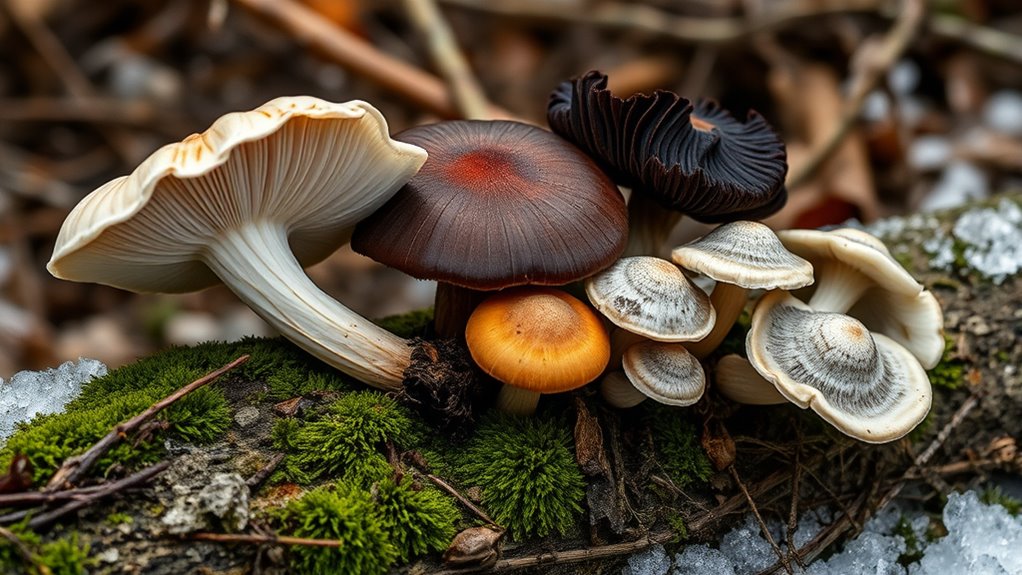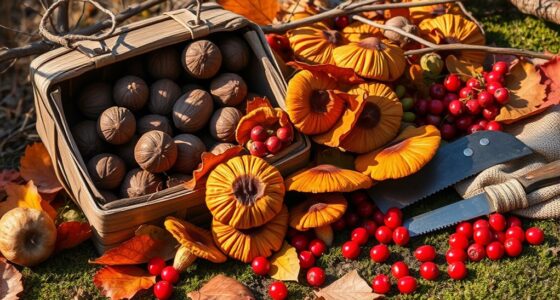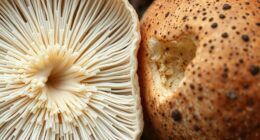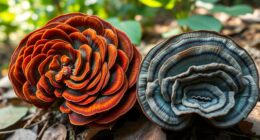Winter mushrooms like velvet shank, wood ear, and oyster offer unique textures and flavors that brighten cold-season dishes. You can recognize velvet shank for its hearty, meaty feel, while wood ear adds crunch and mild earthiness. Oyster mushrooms are perfect for stir-fries and pasta. These resilient fungi symbolize abundance and natural energy, encouraging you to explore more about their foraging and culinary benefits as you continue.
Key Takeaways
- Velvet shank, wood ear, and oyster mushrooms thrive in winter, offering unique textures and flavors for seasonal culinary creations.
- These mushrooms can be foraged sustainably in wooded areas, emphasizing connection to nature and environmental responsibility.
- Velvet shank adds a hearty, meaty texture ideal for stews, while wood ear provides crunch in salads, and oyster mushrooms suit stir-fries.
- Proper identification and cleaning are essential for safety and to fully enjoy their distinctive tastes and culinary versatility.
- Incorporating these wild winter mushrooms symbolizes resilience, natural abundance, and the philosophy of self-reliance in cooking.

Have you ever wondered why winter mushrooms are a sought-after ingredient during the colder months? It’s because they offer a unique way to embrace nature’s rhythm and add vibrant flavor to your meals, even when the ground is frosty. These mushrooms aren’t just ingredients; they’re symbols of freedom from the usual seasonal constraints. When you learn to recognize and gather them, you tap into a natural bounty that awakens your culinary creativity. Foraging tips become your secret weapon—know where to look, like beneath leaf litter or on decaying wood, and pay attention to the subtle signs that signal their presence. With a little practice, you’ll find that winter mushrooms grow in surprising abundance, especially in temperate forests and wooded areas. Their resilience is inspiring—these fungi thrive in cold weather, reminding you that vitality persists despite seasonal chill. Once you’ve identified your find, you can explore countless culinary uses. Velvet shank, wood ear, and oyster mushrooms lend themselves to a variety of dishes. Their textures and flavors are versatile—velvet shank brings a hearty, meaty feel to stews, while wood ear adds crunch and a mild earthiness to salads. Oyster mushrooms shine in stir-fries or as a savory addition to pasta. The key is to treat these fungi with respect, ensuring they’re properly cleaned and cooked thoroughly to discover their best qualities. Foraging tips also include harvesting sustainably—take only what you need and leave enough behind for the ecosystem to flourish. By doing so, you participate in a cycle of abundance and renewal, reinforcing your connection to nature’s generosity. Think of these mushrooms as your allies in the pursuit of culinary liberation—ingredients that elevate simple dishes into expressions of freedom and self-reliance. As you incorporate winter mushrooms into your cooking, you embrace a lifestyle that rejects dependency on store-bought produce, instead turning to the wild for nourishment. Their presence in your kitchen reminds you that nature’s gifts are available to those willing to seek them out. Whether you’re simmering a velvety mushroom broth or stir-frying wood ear with garlic and ginger, you’re asserting your independence from processed foods and embracing the raw, untamed flavors of the forest. Recognizing the types of mushrooms that grow in winter can also help you make informed foraging decisions based on Louisiana alimony laws and sustainable practices. So, get out there, sharpen your foraging tips, and discover how these winter mushrooms can transform your meals—and your perspective—toward a more liberated, self-sufficient way of living.
Frequently Asked Questions
How Should Winter Mushrooms Be Stored for Freshness?
You should store winter mushrooms in a paper bag in the fridge to keep them fresh. Avoid plastic, as it traps moisture and causes spoilage. For ideal freshness preservation, place the bag in a cool, dry spot and use the mushrooms within a few days. If you want to free yourself from spoilage worries, keep them well-ventilated and check regularly for signs of decay.
Are Winter Mushrooms Safe to Eat Raw?
You can eat winter mushrooms raw, but be aware that about 70% of mushroom toxins are destroyed during cooking. While some varieties like oyster mushrooms are safe raw, others like wood ear require safety precautions due to potential bacteria. For a fearless culinary experience, always wash thoroughly and consider cooking to maximize safety and flavor. Trust your senses and enjoy the crunch, but prioritize safety for a liberated, delicious adventure.
What Are the Nutritional Benefits of Winter Mushrooms?
Winter mushrooms offer impressive nutritional benefits. You’ll get a boost of antioxidants that fight free radicals, supporting your immune system. They’re rich in vitamins like B vitamins and vitamin D, helping boost your energy and bone health. By including these mushrooms in your diet, you empower your body with essential nutrients that promote vigor and well-being. Embrace their health perks and take control of your nutrition with every flavorful bite.
How Can I Identify Wild Winter Mushroom Varieties?
Imagine opening nature’s hidden treasures through mushroom foraging, where identifying edible varieties feels like reclaiming your freedom. To do so, observe key features: Velvet Shank’s smooth, reddish-brown stalk; Wood Ear’s translucent, ear-shaped cap; and Oyster mushrooms’ fan-like, grayish appearance. Always check spore color, gill attachment, and habitat. Trust your senses, and remember—when in doubt, consult a seasoned forager. Liberation begins with confident, safe identification.
What Are Common Cooking Methods for Velvet Shank, Wood Ear, and Oyster Mushrooms?
You should sauté velvet shank, wood ear, and oyster mushrooms with garlic and herbs to enhance their natural flavors. Stir-frying or quick steaming preserves their texture and taste. Try flavor pairings like soy sauce, ginger, or sesame oil for a savory kick. These cooking techniques release their unique qualities, giving you a liberating culinary experience that celebrates their earthy, umami richness. Enjoy experimenting and making these mushrooms your own!
Conclusion
So, next time you’re foraging in winter’s chill, don’t overlook these hearty mushrooms like velvet shank, wood ear, and oyster. They bring a touch of culinary magic to your table, even in the coldest months. Think of them as your secret weapon, like a trusty sidekick from a classic adventure novel. With a little know-how, you’ll be enjoying wild, flavorful dishes that make winter feel a bit more like a cozy, enchanted cottage.










